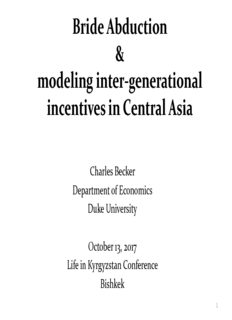
Bride Abduction and Modeling Inter Generational Incentives PDF
Preview Bride Abduction and Modeling Inter Generational Incentives
Bride Abduction & modeling inter-generational incentives in Central Asia Charles Becker Department of Economics Duke University October 13, 2017 Life in Kyrgyzstan Conference Bishkek 1 Outline • 20 years ago… • Background: bride kidnapping and patrilocality • LiK empirical work on patrilocality • Patrilocality and violence against young women: evidence from Tajikistan • LiK empirical work on bride kidnapping • An unrelated (?) issue: rising wealth inequality 2 References • Becker, Charles M., Bakhrom Mirkasimov, and Susan Steiner. "Forced marriage and birth outcomes." Demography 54.4 (2017): 1401-1423. • Landmann, Andreas, Helke Seitz, and Susan Steiner. Patrilocal Residence and Female Labour Supply. No. 10890. Institute for the Study of Labor (IZA), 2017. • Becker, Charles Maxwell, and Mavzuna Turaeva. "Queen Bees and Domestic Violence: Patrilocal Marriage in Tajikistan." Economic Research Initiatives at Duke (ERID) (2016). • An, Galina, Charles Becker, and Enoch Cheng. “Bubbles on the Steppe: Intrinsic Bubbles and Credit Expansion in Kazakhstan’s Real Estate Market.” https://ssrn.com/abstract=3044009 Economic Research Initiatives at Duke (ERID) (2017). 3 20 years ago … • I started work in Kyrgyzstan on June 11, 1998, as Team Leader for the Asian Development Bank’s Pension Reform Technical Assistance project. • It immediately became clear that this would not be easy: 4 20 years ago… • But the most difficult part was lack of information. • That was not because of lack of effort by the Kyrgyz Government or international LSMS and DHS surveys. Rather, conditions were unstable, and hence it was very difficult to draw inferences from the data. • And, given the difficulty of conditions, we focused on emergency topics - 5 20 years ago… – Collapsing registered marriage – Rapidly declining birth rates – Collapsing employment and tax revenues – A sharp decline in life expectancy – Vastly under-reported infant mortality – Large government deficits • Sergey Paltsev and I estimated that for every som collected in social payments from rural areas and small cities, 11 som were paid out. • We also made 50 year pension system forecasts but confidence intervals were violated after 3-5 years. 6 20 years ago… • I mention this because it is important to maintain perspective and understanding of how far Kyrgyzstan has come. • We are now in a generation of economic and social analysis that is highly informed, thanks to the National Statistics Committee http://www.stat.kg/en/ and to many social surveys, of which the Life in Kyrgyzstan survey is probably most important. • This information will be valuable for identifying and understanding major social problems, and designing social policy responses. 7 Background: bride abduction in Kyrgyzstan • Anthropologists have extensively studied the practice of bride abduction and find that it disappeared in most countries with the development of modern laws and social norms (Stross 1974; McLaren 2001) • Historically, Kyrgyz people are traditional nomads with a herding culture. The traditional role of a woman was a housekeeper (Abazov 2004). Nomadic culture resulted in significant female autonomy and empowerment relative to neighboring sedentary populations. • Under Soviet rule, laws were established in the 1920s that banned forced marriages. Women were generally well-integrated into the labor force and public life. Kyrgyzstan had Central Asia’s and indeed the former USSR’s first woman president in 2010. 8 Background: Ala kachuu statistics • No official data on the number of kidnappings that occur each year: up to a third of all ethnic Kyrgyz women may have married non-consensually kidnapping (Kleinbach 2003). Several sources indicate that approximately 15,000 girls are kidnapped and forced into marriage annually. • According to a single village survey conducted in 2004, 80 percent of Kyrgyz marriages were the result of ala kachuu, and 57 percent of these marriages were non-consensual (Kleinbach et al. 2005). They suggest there is an increase over the last 40-50 years. • According to a 2011-2012 nationally representative survey collected on men and women in Kyrgyzstan, one-third of marriages were the result of kidnappings among Kyrgyz; half of these marriages were of forced nature (Agadjanian and Nedoluzhko 2013). They suggest there is a decline since the collapse of the USSR. • These last numbers are broadly consistent with LiK 2011 and 2016 survey data. The way in which the question is phrased, the nature of related questions, and the interview process all may affect responses. 9 Background: Patrilocality • In many if not all Central Asian societies, a high proportion of newlyweds will live with the husband’s parents, especially in the case where the groom is also the youngest son. This is known as patrilocality. • In three-generation households, the younger couple – and especially the younger wife – is subservient to the older generation. • This loss of autonomy is documented and the consequences are discussed below for both Kyrgyzstan and Tajikistan. 10
Description: